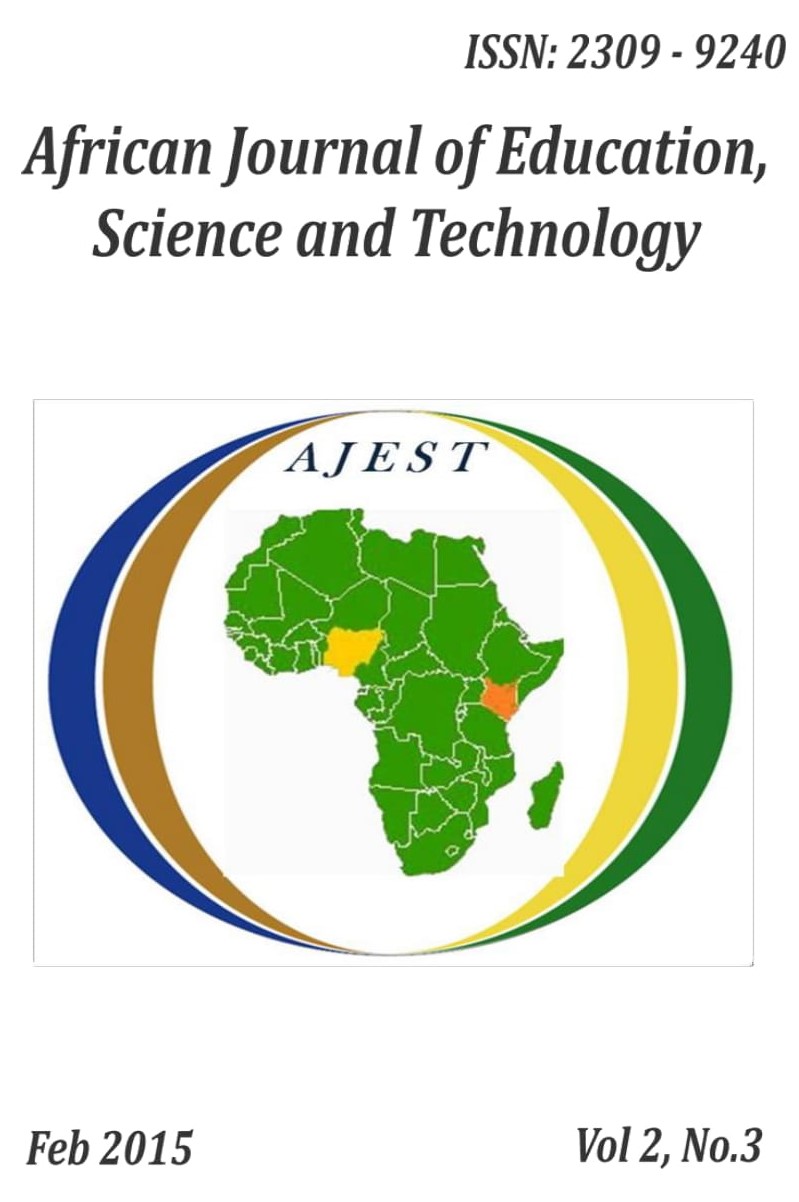Lecture Non-Attendance by University Students: Triggers and Solutions
##article.abstract##
Lecture non-attendance by university students is a major issue in many institutions of higher learning globally. This study was conducted to determine the institutional-based factors and student-centered factors that cause absenteeism among undergraduate students in a public university in Kenya. This paper focuses on what we consider to be one of the impacts of demographic changes in the university where we teach. We have both witnessed chronic cases of absenteeism; an observation that informed this study. We carried out the research with two groups of students from one teaching department in June and October 2013. The June group comprised of 1st years (N=68) that were in their second semester, and the October group comprised of 3rd years in their first semester (N=84). The groups were purposively selected; the first years were relatively new to a university environment whereas the 3rd years were considered to be „at home‟. A self-administered questionnaire with open ended items was developed and administered to the groups in their respective homogenous cohorts. Through the questionnaires we sought to find out reasons why students in our university miss lectures. We also requested the respondents to suggest measures that should be taken to curb absenteeism at the university. Mixed method of data analysis was used. Based on findings, we categorized the students‟ responses on causes of absenteeism into two; institutional-based factors and student-centered factors. The suggested solutions mainly focused on the actions to be taken by the university. Given the current demographic trends in Kenyan universities, the students raised critical issues that touch on quality of services, leadership and management of university operations. The university needs to enact policies that monitor and evaluate its core business.
References
Arulampalam, W., Naylor, R., & Smith, J. (2007, November). Am I missing something? The effects of absence
from class on student performance. Economic Research Paper No. 820. Coventry, UK: University
of Warwick. Retrieved (n.d.), from
http://wrap.warwick.ac.uk/1396/1/WRAP_Arulampalam_twerp_820.pdf
Broder, J. M. (1994). Empirism and the art of teaching. Journal of Agricultural and Applied Economics, 25 (July), 1-18
Clay, T., & Brewslow, L. (2006). Why students don‘t attend class. MIT Faculty Newsletter, 18 (March/April), 6-7
Desalegn, A. A., Berhan, A. & Berhan, Y. (2014). Absenteeism among medical and health science undergraduate students at Hawassa University, Ethiopia. A Journal of BMC Medical Education. http://www.biomedcentral.com/1472-6920/14/81
Fayombo, G. A., Ogunkola, B. J., & Olaleye, Y. L. (2012). Cross Institutional Study of the Causes of Absenteeism among University Students in Barbados and Nigeria. Journal of Educational and Development Psychology 2 (1), May 2012. www.ccsenet.org/jedp
Gagner, R. (1985). The Conditions of Learning and the Theory of Instruction (4th ed.). New York: Holt, Rinehart and Winston.
Gump, S.E. (2006). ‗Guess who‘s (not) coming to class: students attitudes as indicators of attendance‘, Educational Studies 32 (1), 39–46.
Gump, S. (2004). Keep students coming by keeping them interested: Motivators for class attendance. College Student Journal, 38(1), 157–160.
Hughes, S.J. (2005). ‗Student attendance during college-based lectures: a pilot study‘, Nursing Standard 19 (47), 41–49.
Hunter, S., & Tetley, J. (1999). ‗Lectures. Why don‘t students attend? Why do students attend?‘ Proceedings of HERDSA Annual International Conference held in Melbourne 12–15 July 1999, Higher Education Research and Development Society of Australia, Milperra, NSW.
Khamasi, J.W. (2001). Nurturing pedagogical practices. A chapter in Action Research and Teacher Education Year Book for the American Association of Family and Consumer Science 2001
Khamasi, J.W. (2004). Teaching journaling: reflections on the challenges. In Enhanced Learning Cultures.
Australian Academic Press Pty. ISBN: 1-8753-7851-0.
Khamasi J.W. (2005). Journal writing as a tool of qualitative assessment in a Kenya higher education context. Journal of Authentic Learning (electronic journal) http://www.oswego/edu/jal/vol1/ khamasi/pdf/
Kottasz, R. (2005). Reasons for student non-attendance at lectures and tutorials: an analysis. Investigations in University Teaching and Learning, 2(2), 5–16. ISSN 1740-5106
Longhurst, R.J. (1999). ‗Why aren‘t they here? Student absenteeism in a further education college‘, Journal of Further and Higher Education 23 (1), 61–80.
Marburger, D.R. (2001). Absenteeism and Undergraduate Exam Performance. UK: Heldref Publications.
Massingham, P., & Herrington, T. (2006). Does attendance matter? An examination of student attitudes, participation, performance and attendance. Journal of University Teaching & Learning Practice, 3(2), 83–103. Retrieved (n.d.), from http://ro.uow.edu.au/jutlp/vol3/iss2/3
Mayer, G., & Mitchell, L. (1996). A drop-out prevention programme for at-risk high school students: Emphasising consulting to promote positive classroom climates. Educational Treatment of Children, 16, 135-138.
Misaro, J., Jonyo, F. O., & Kariuki, D. K. (2013). A review of the impact of Massification on the quality of Higher Education in Kenya. Research Journal in Organizational Psychology and Educational Studies 2 (4) 139-149. www.emergingresources.org
Musembi, O (2011 June 20, p.9). Varsity Double Intake Opposed. Daily Nation. Nairobi: Nation Media Group
Nicholl, H., & Timmins, F. (2005) ‗Programme-related stressors among part-time undergraduate nursing students‘, Journal of Advanced Nursing 50 (1), 93–100.
Republic of Kenya (2013). Kenya Population Analysis: Report of 2009 census. Nairobi: Government Printers
Timmins, F., & Kaliszer, M. (2002) ‗Attitudes to absenteeism among diploma nursing students in Ireland – an exploratory descriptive survey‘, Nurse Education Today 22 (7), 578–588.
Wadesango, N., & Machingambi, S. (2011). Causes and structural effects of student absenteeism: a case study of three South African Universities. J Soc Sci 26(2), 89–97.
Weller, D.L. (1996). The next generation of school reform. Quality Progress, 29, 65-70.
Westrick, S., Helms, K., McDonough, S., & Breland, M. (2009). Factors influencing pharmacy students‘ attendance decisions in large lectures. American Journal of Pharmaceutical Education, 73(5), 1–9.
Williams, L.L. (2000). Student absenteeism and truancy. Technologies and interventions to reduce chronic problems among school-age. Journal of Children, 7, 23-34.


